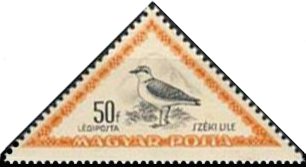Stamp: Kentish Plover (Charadrius alexandrinus) (Hungary 1952)
Kentish Plover (Charadrius alexandrinus) (Hungary 1952)
16 March (Hungary ) within release Birds (1952) goes into circulation Stamp Kentish Plover (Charadrius alexandrinus) face value 50 Hungarian fillér
| Stamp Kentish Plover (Charadrius alexandrinus) in catalogues | |
|---|---|
| Michel: | Mi:HU 1233 |
| Stamp Number: | Sn:HU C99 |
Stamp is horizontal format.
AirmailAlso in the issue Birds (1952):
- Stamp - Golden Oriole (Oriolus oriolus) face value 40;
- Stamp - Pied Avocet (Recurvirostra avosetta) face value 20;
- Stamp - White Stork (Ciconia ciconia) face value 30;
- Stamp - Kentish Plover (Charadrius alexandrinus) face value 50;
- Stamp - Black-winged Stilt (Himantopus himantopus) face value 60;
- Stamp - Lesser Grey Shrike (Lanius minor) face value 70;
- Stamp - Great Bustard (Otis tarda) face value 80;
- Stamp - Red-footed Falcon (Falco vespertinus) face value 1;
- Stamp - European Bee-eater (Merops apiaster) face value 1.40;
- Stamp - Glossy Ibis (Plegadis falcinellus) face value 1.60;
- Stamp - Great White Egret (Ardea alba) face value 2.50;
- Stamp - Black-winged Stilt (Himantopus himantopus) face value 60;
- Stamp - Black-winged Stilt (Himantopus himantopus) face value 60;
- Tete-Beche - Black-winged Stilt (Himantopus himantopus) face value 2*60;
- Tete-Beche - Black-winged Stilt (Himantopus himantopus) face value 2*60;
- Stamp - Glossy Ibis (Plegadis falcinellus) face value 1.60;
- Stamp - Glossy Ibis (Plegadis falcinellus) face value 1.60;
- Tete-Beche - Glossy Ibis (Plegadis falcinellus) face value 2*1.60;
- Tete-Beche - Glossy Ibis (Plegadis falcinellus) face value 2*1.60;
- Stamp - Golden Oriole (Oriolus oriolus) face value 40;
- Stamp - Golden Oriole (Oriolus oriolus) face value 40;
- Stamp - Golden Oriole (Oriolus oriolus) face value 40;
- Tete-Beche - Golden Oriole (Oriolus oriolus) face value 2*40;
- Tete-Beche - Golden Oriole (Oriolus oriolus) face value 2*40;
- Stamp - Great Bustard (Otis tarda) face value 80;
- Stamp - Great Bustard (Otis tarda) face value 80;
- Tete-Beche - Great Bustard (Otis tarda) face value 2*80;
- Tete-Beche - Great Bustard (Otis tarda) face value 2*80;
- Stamp - Great White Egret (Ardea alba) face value 2.50;
- Stamp - Pied Avocet (Recurvirostra avosetta) face value 20;
- Stamp - Pied Avocet (Recurvirostra avosetta) face value 20;
- Stamp - Pied Avocet (Recurvirostra avosetta) face value 20;
- Tete-Beche - Pied Avocet (Recurvirostra avosetta) face value 2*20;
- Tete-Beche - Pied Avocet (Recurvirostra avosetta) face value 2*20;
- Stamp - White Stork (Ciconia ciconia) face value 30;
- Stamp - White Stork (Ciconia ciconia) face value 30;
- Tete-Beche - White Stork (Ciconia ciconia) face value 2*30;
- Tete-Beche - White Stork (Ciconia ciconia) face value 2*30;
- Stamp - White Stork (Ciconia ciconia) face value 30;
Stamp Kentish Plover (Charadrius alexandrinus) it reflects the thematic directions:
Birds (Aves), a subgroup of Reptiles, are the last living examples of Dinosaurs. They are a group of endothermic vertebrates, characterised by feathers, toothless beaked jaws, the laying of hard-shelled eggs, a high metabolic rate, a four-chambered heart, and a strong yet lightweight skeleton. Birds live worldwide and range in size from the 5 cm (2 in) bee hummingbird to the 2.75 m (9 ft) ostrich. They rank as the class of tetrapods with the most living species, at approximately ten thousand, with more than half of these being passerines, sometimes known as perching birds. Birds are the closest living relatives of crocodilians.
Animals are multicellular, eukaryotic organisms of the kingdom Animalia (also called Metazoa). All animals are motile, meaning they can move spontaneously and independently, at some point in their lives. Their body plan eventually becomes fixed as they develop, although some undergo a process of metamorphosis later on in their lives. All animals are heterotrophs: they must ingest other organisms or their products for sustenance.
The Kionga Triangle (German: Kionga-Dreieck, Portuguese: Triângulo de Quionga) was a small region of German East Africa situated at the mouth of the Ruvuma River. The Ruvuma served as the border between the German colony and Portuguese Mozambique, and the Kionga Triangle was the only section of German East Africa south of the river. Its principal settlement was Kionga (now Quionga ) which had a population of 4,000 in 1910. It became a German possession in 1894 but came under Portuguese control in April 1916 during World War I. The post-war Treaty of Versailles reaffirmed that the river was the border between Tanganyika, then under British control, and Portuguese Mozambique. The triangle was the only territory that the treaty awarded to Portugal.


